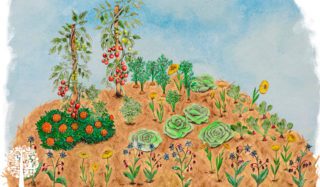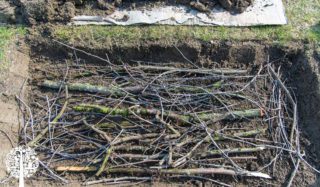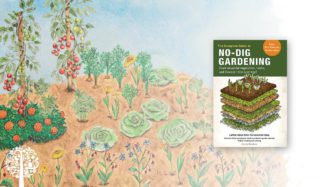Are you looking for a gardening method with no back-breaking work or expensive inputs? Then look no further than Hugelkultur! This no-dig technique has been around for centuries and involves creating thriving gardens from woody debris and other natural materials found around the yard. You’ll not only recycle logs, branches, and fallen leaves, but you’ll also be sequestering carbon and helping fight climate change. Go, you!
What Is Hugelkultur?
Hugelkultur is a German word meaning “hill mound” or “mound culture”. And even though traditional practice involves building a hill or mound to grow on, you can also incorporate hugelkultur into raised beds and containers. The best part? It’s easy to do; gather soil and other woody debris from the yard and build your gardens on top of it.
The Benefits of Hugelkultur

Before we learn how to build a hugelkultur garden, here are some of the benefits:
- You’ll recycle and reuse naturally decomposing materials from around the yard.
- No-digging, saving precious soil life and your back! Need we say more?
- The natural materials will break down over time, continuously feeding the soil and your plants.
- The raw materials retain moisture, meaning less time wrestling with the hose.
- Natural decomposition keeps the earth warmer, perfect for growing in colder climates.
- The logs used at the bottom of the bed store carbon, meaning it won’t get released into the atmosphere.
- This technique works on rocky and compacted soil.
How To Build A Hugelkultur Garden
Making a hugelkultur garden bed is similar to making a lasagna; it involves a lot of layering.
First, select a site for the garden and be sure you won’t be moving it anytime soon. Remember, this bed is built to decompose over many years, up to 20, depending on the size you create. So you don’t want to be messing with it by changing locations.
Once you’ve chosen your spot, walk around your landscape and collect some dead logs, twigs, and branches. Hardwood (maple, ash, oak, birch) is recommended because it takes longer to break down than softwood, but fallen poplar trees will work well too.

Build a log pile anywhere between one and three feet tall. Make sure it’s nice and snug. You don’t want your garden to fall apart. Although hugelkultur is a no-dig method, some gardeners like to dig a trench to begin so the logs rest nicely at the bottom. If you’re using raised beds, there is no need to dig at all.
Once you’ve placed your logs and branches, cover them with a layer of nitrogen-rich material, like grass clippings, sod (upside down), compost, seaweed, or aged manure. You can add some garden soil too. These will help begin the decomposition process with the logs.
Cover the nitrogen layer with 6-12 inches of hay, straw, wood chips, or shredded leaves. This material will act as a mulch and help with water retention.
Surrounding the mound or garden bed with rocks or logs will keep the soil from washing away.
Growing In Your Hugelkultur Garden
Now that you’ve created your garden, it’s time to start growing.
If you have layered the above materials in a deep raised garden bed, you can plant as usual and reap the benefits of the slow decomposition. Doing this will save you a ton of money; you won’t have to order as much earth or compost to fill the bed.
If you’ve created a hill or mound, remember that the top of the garden will be pretty dry, so plant crops that can tolerate arid conditions higher and thirsty crops toward the bottom of the hill.
Remember that although you have a layer of nitrogen-rich material in the garden, it takes time to decompose. So, in your first year of hugelkultur, you’ll likely need to add more compost than usual.
After year one, you won’t need to worry about this so much, but you’ll need to spread a thin layer of compost on the top before planting.

Happy Hugelkultur Gardening!
We love Charlie Nardozzi’s guide to hugelkultur gardening and no-dig techniques in general in The Complete Guide to No-Dig Gardening: Grow beautiful vegetables, herbs, and flowers – the easy way!